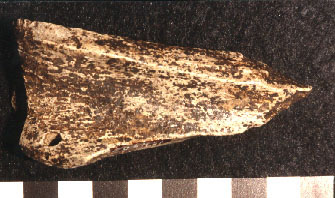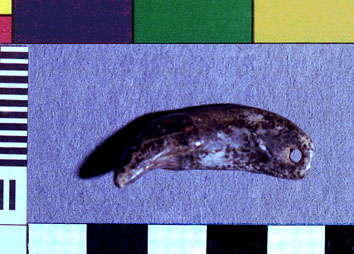History of Knots
For mathematicians, the first object of study is the form of a
knot, since other properties of interest to a practical knot tyer,
as in the Ashley Book of Knots, are difficult to deal with mathematically, and in any case require
first an understanding of form.
The use of cordage by humans goes back into prehistory. The oldest
known pierced object is over 300,000 years old, and was found
in Austria in the Repolusthöhle.
The book History and Science of Knots
Edited by J.C.TURNER and P VAN DE GRIEND, Published by World Scientific.
1995
gives a good coverage of many facets of the History and Science
of Knots. The use of cordage by humans goes back into prehistory.
From Part I. Prehistory and Antiquity (Page 8)
`At Terra Amata, near Nice, there are 10 sites with stones and
post holes presumably outlining dwellings, with occupational litter
and hearths inside, dated at around 380,000 years ago. The poles
may have been covered with skins or thatch; cordage may have been
used to stabilise the structure or fasten the covering.
Cordage is also likely to have been used for suspending perforated
objects. Beads or pendants begin around 300,000 years ago, the
two oldest known specimens having been excavated in an Austrian
cave, the Repolusthöhle. One is a nicely drilled wolf incisor,
the other is a triangular, flaked bone point, perforated at the
base, as shown in pictures below.
Spherical stones occur frequently in Lower Palaeolithic occupation
sites up to at least 500 000 years old, in both Africa and China.
They are usually from 6 to 12 cm in diameter, and it has been
suggested that they may have been used as bola weights in hunting.
If that were correct, it would undeniably prove the use of both
cordage and knots, indeed probably some sort of bag or netting
to hold the stones as well.'
Below you can see drawings and photographs of two perforated objects
(flaked bone point and wolf incisor) from Middle Palaeolithic
layers of the Repolstuhle, Syria. It has been proposed on the
basis of the phylogeny of the bear remains at this location that
the occupation deposits are nearly 300,000 years old.

|
These two drawings of the objects pictured below are taken from
Robert G. Bednarik, `Palaeoart and archaelological myths', Cambridge
Archaeological Journal, 2(1) (1992) 27-57, and the photographs
have been supplied by him and are reproduced with his permission.
(All copyright R.G. Bednarik) |

|
 |
|
FLAKED BONE POINT
|
WOLF INCISOR
|
Perhaps the Stone Age should be called the Age of String! The
string itself quickly perished. The brain power which developed
to see how to tie axes, spears, slings, to make fishing nets,
to sew clothes, to bind vegetation for shelter, to improve chances
of survival, and to decorate for enjoyment and display - is part
of ourselves. This understanding of the form of a twisted line
must be one of the oldest forms of applied geometry.
The use of knots, links and braids in art and imagery is a huge
topic. There is the extraordinary interlacing of Celtic Art, of
which the most famous is the Book of Kells. Myriads of examples occur across the world.
Back to Aims

© Mathematics and Knots/Edition Limitee 1996 - 2002
This material may be used freely for educational, artistic and
scientific purposes, with acknowledgement, but may not be used for commercial purposes, for profit or in texts
without the permission of the publishers.


